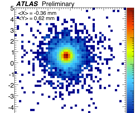Research



ATLAS Experiment:
-
•Silicon pixel detector hardware testing and calibration. I was responsible for the synchronization of the entire detector, and provided the crucial first measurements that allowed for a full-detector tuning and thus the ability to meet the strict timing requirements for the experiment.
-
•I participated heavily in the construction, installation, and commissioning of the hadronic tile calorimeter for the ATLAS detector. I performed the duty as front-end electronics team leader, being responsible for coordinating and reporting the progress and quality control of the read-out chain integrity and readiness.
-
•I have been involved in all aspects of the online measurement and characterization of the LHC beam position and profile within ATLAS. The algorithm design, implementation, system testing and finally online integration within the ATLAS trigger system were my responsibility and resulted in the first joint LHC-ATLAS conference paper.
CAST Experiment:
-
•Search for hadronic axions with a high purity inorganic scintillating crystal calorimeter.
Previous research


-
•Electronics and triggers for the energy frontier. My group is currently involved in constructing extremely fast electronics systems (triggers) for selecting interesting physics processes that might otherwise go unnoticed. Specifically, the development of a so-called Level 1 (i.e. very fast) boosted object trigger for Run III of the LHC.
-
•Searches for new physics. In particular, supersymmetric (SUSY) particles that decay in predominantly hadronic final states. This class of theories may answer questions such as the hierarchy problem (i.e. why do the forces that we know of have such a large range of strengths?) or what is the dark matter.
-
•Searches for boosted hadronic objects. Several new physics models (not only SUSY) predict that new heavy particles may decay into much lighter final states including W/Z/h bosons and top quarks. The LHC has a high enough energy that this becomes possible. The experimental tools for studying such scenarios is a strong focus of mine.
-
•Measurement of the energy flow in hadronic final states. Quantum chromodynamics (QCD) offers detailed predictions of the relationship of quarks and gluons to one another. Tests of these predictions not only shed more light on our current understanding of the theoretical tools and the theory itself, but may also aid in searching for new physics.
-
•Calibration and precisions measurements of jets. Jets are the experimental signatures of quarks and gluons. An accurate and precise understanding of their properties and calibration is thus crucial for each of the interests listed above.
-
•Understanding and mitigating pile-up. The presence of multiple simultaneous proton-proton collisions is a harsh reality of the design of the LHC. This presents numerous problems, in particular for a precision measurement of the hardonic final state.
Current areas of interest
I am an experimental physicist. This can mean many things to many people, but in my case it means that I am interested in testing both current models and theories of how the universe works -- Quantum Chromodynamics (QCD) for example -- as well as devising new ways and new instruments to tease out the answers to those questions that most plague us as scientists. I believe the methods used to answer those questions to be almost as exciting as the answers themselves, and indeed have led to some of the most influential technologies available today: GPS, MRI, tire manufacturing, and so on.
Currently, I work on the ATLAS Experiment at the Large Hadron Collider at CERN.
The first part of my research focuses on the measurement of particles that make up the protons and neutrons with which we are so familiar: quarks and gluons. The second part (if the delineation were really so clear) is the search for new physics, and in particular: searches for supersymmetric partners of the particles of the Standard Model of Particle Physics.
For more details than found below, see also: